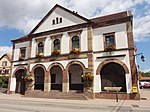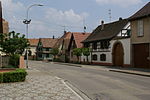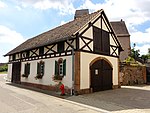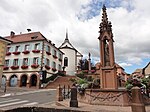Niedernai

Niedernai (German: Niederehnheim) is a commune in the Bas-Rhin department in Alsace in north-eastern France. It is located 26km south west of Strasbourg, 23km north of Sélestat and 50km north of Colmar on the main A35 road. Niedernai dates back to pre-Roman times. In 707, it was part of the lands of the Feldkirch monastery, founded by the Benedictine monks of Moyenmoutier. From 1284, it was the seat of the Landsberg family, who built a fortified castle. The remnants of the castle can be seen in the "Glockenturm" watchtower. The former Sainte Barbe church dates from 1741. By the 1850s it was too small for the congregation, so plans were begun for a new church. The parish church of Saint Maximin was built between 1891 and 1893. The former Sainte Barbe church is now a school. Niedernai is characterised by traditional wood-framed houses.
Excerpt from the Wikipedia article Niedernai (License: CC BY-SA 3.0, Authors, Images).Niedernai
Rue des Païens, Sélestat-Erstein
Geographical coordinates (GPS) Address Nearby Places Show on map
Geographical coordinates (GPS)
| Latitude | Longitude |
|---|---|
| N 48.4483 ° | E 7.5169 ° |
Address
Rue des Païens 85a
67210 Sélestat-Erstein
Grand Est, France
Open on Google Maps









